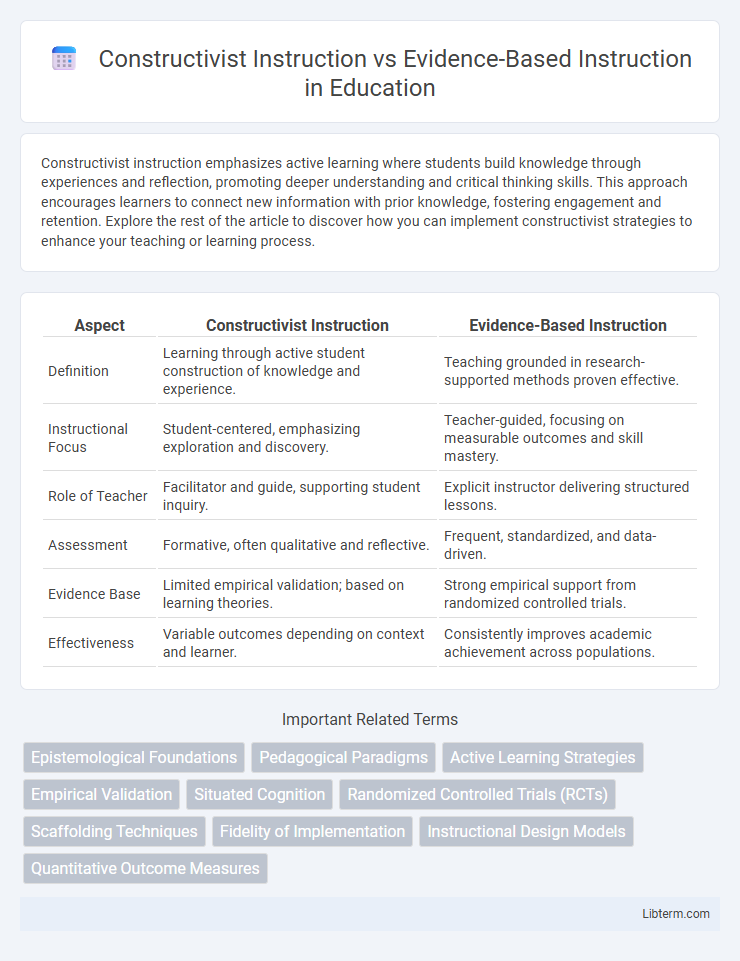Constructivist instruction emphasizes active learning where students build knowledge through experiences and reflection, promoting deeper understanding and critical thinking skills. This approach encourages learners to connect new information with prior knowledge, fostering engagement and retention. Explore the rest of the article to discover how you can implement constructivist strategies to enhance your teaching or learning process.
Table of Comparison
| Aspect | Constructivist Instruction | Evidence-Based Instruction |
|---|---|---|
| Definition | Learning through active student construction of knowledge and experience. | Teaching grounded in research-supported methods proven effective. |
| Instructional Focus | Student-centered, emphasizing exploration and discovery. | Teacher-guided, focusing on measurable outcomes and skill mastery. |
| Role of Teacher | Facilitator and guide, supporting student inquiry. | Explicit instructor delivering structured lessons. |
| Assessment | Formative, often qualitative and reflective. | Frequent, standardized, and data-driven. |
| Evidence Base | Limited empirical validation; based on learning theories. | Strong empirical support from randomized controlled trials. |
| Effectiveness | Variable outcomes depending on context and learner. | Consistently improves academic achievement across populations. |
Introduction to Constructivist and Evidence-Based Instruction
Constructivist instruction centers on learners building knowledge through active engagement and personal experiences, emphasizing critical thinking and problem-solving skills. Evidence-based instruction relies on rigorously tested methods and empirical research to guide teaching practices, ensuring effectiveness and measurable student outcomes. Both approaches aim to enhance learning but differ in their foundation: constructivism prioritizes learner-centered exploration, while evidence-based instruction focuses on data-driven strategies.
Defining Constructivist Instruction: Key Principles
Constructivist instruction centers on the principle that learners actively construct knowledge through experience and reflection, emphasizing problem-solving and critical thinking. Key principles include learner-centered environments, scaffolding, and the integration of real-world contexts to facilitate deeper understanding. This approach contrasts with evidence-based instruction by prioritizing individual meaning-making and adaptive learning processes over standardized methods.
Understanding Evidence-Based Instruction: Core Concepts
Evidence-Based Instruction centers on applying teaching methods validated by rigorous scientific research to improve student outcomes. Core concepts include the systematic integration of empirical evidence, expert knowledge, and contextual factors to design effective instructional strategies. This approach emphasizes measurable results, data-driven decision making, and continuous assessment to enhance learning efficacy.
Comparing Pedagogical Foundations
Constructivist instruction centers on learners actively building knowledge through experience and reflection, emphasizing collaboration and contextual learning. Evidence-based instruction relies on empirical research and scientifically validated strategies, prioritizing measurable outcomes and reproducibility. Pedagogical foundations diverge as constructivism values subjective meaning-making, while evidence-based methods stress objective data-driven practices.
Role of the Teacher: Facilitator vs. Implementer
In constructivist instruction, the teacher acts as a facilitator who guides students to actively construct their own understanding through exploration and inquiry. In contrast, evidence-based instruction positions the teacher as an implementer who delivers systematically researched strategies and explicit guidance to ensure effective learning outcomes. The facilitator role emphasizes student-centered discovery, while the implementer role prioritizes fidelity to proven instructional practices for maximizing achievement.
Impact on Student Learning Outcomes
Constructivist instruction emphasizes active learning where students build knowledge through experience, fostering deep understanding and critical thinking skills that enhance problem-solving abilities and long-term retention. Evidence-based instruction relies on rigorously tested teaching methods and interventions demonstrating statistically significant improvements in standardized assessments and measurable academic performance. Combining constructivist approaches with evidence-based strategies leads to optimized student learning outcomes by balancing conceptual engagement with empirically supported techniques.
Curriculum Design and Implementation
Constructivist instruction emphasizes curriculum design that fosters active learner engagement through problem-solving and experiential activities, promoting knowledge construction based on prior experiences. Evidence-based instruction relies on curricula grounded in empirical research and data-driven practices, ensuring systematic implementation of teaching strategies proven to enhance learning outcomes. Integrating both approaches requires balancing learner-centered exploration with rigorously validated instructional methods to optimize educational effectiveness.
Assessment Methods and Evaluation
Constructivist instruction emphasizes formative assessments such as reflective journals, peer evaluations, and project-based tasks to gauge students' understanding through active learning experiences. Evidence-based instruction relies heavily on standardized tests, rubrics, and data-driven analysis to measure learning outcomes objectively and ensure instructional effectiveness. Both approaches prioritize continuous evaluation, but constructivist methods focus on qualitative insights while evidence-based strategies emphasize quantitative metrics.
Challenges and Criticisms of Each Approach
Constructivist instruction faces challenges related to its reliance on student-driven discovery, which can lead to inconsistent learning outcomes and difficulties in assessing mastery of core concepts. Evidence-based instruction is criticized for potentially limiting creativity and failing to address diverse learner needs due to its standardized, research-driven methods. Both approaches struggle with balancing theoretical ideals and practical classroom applicability, often requiring significant teacher training and adaptation.
Integrating Constructivist and Evidence-Based Practices
Integrating constructivist instruction with evidence-based practices enhances student learning by combining active, student-centered exploration with rigorously tested teaching methods. This blended approach leverages constructivism's emphasis on meaningful, contextualized learning while using evidence-based strategies to provide clear guidance, feedback, and measurable outcomes. Research shows that hybrid models improve critical thinking and retention rates by aligning teaching techniques with cognitive science and real-world applications.
Constructivist Instruction Infographic

 libterm.com
libterm.com